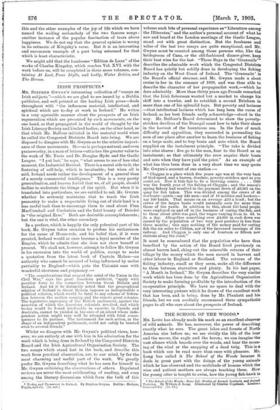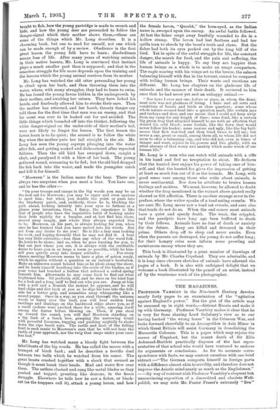THE SCHOOL OF THE WOODS.*
Mn. LONG has already made his mark as an excellent observer of wild animals. He has, moreover, the power of describing exactly what he sees. The great lakes and forests of North America rise before us; we see vividly the life of the bear and the moose, the eagle and the heron; we can imagine the vast silence which broods over the woods, and hear the moan- ing of the wind or the snapping of a dead twig. This is a book which can be read more than once with pleasure. Mr. Long has called it The School of the Woods because it deals in great part with the doings of the young animals which he has observed and the multitude of lessons which the wise and patient mothers are always teaching them. How the young otter is taught to swim, how the young fish-hawk * The School of the Woods : Scene Life Studies of Animal Instincts and Animal. Training. By William J. Long. Illustrated by Charles Copeland. London c Ginn and Co. [7s. 61]
taught to fish, how the young partridge is made to crouch and bide, and how the young deer are persuaded to follow the danger-signal which their mother shows them,—these are some of the things which Mr. Long describes. It is a
charming book, but one to read for oneself, not one which can be made enough of by a review. Obedience is the first
great lesson the young folk have to learn ; disobedience means loss of life. After many years of watching animals in their native haunts, Mr. Long is convinced that instinct plays a much smaller part than is supposed; and that in the ceaseless struggle for life more depends upon the training and the lessons which the young animal receives from its mother.
Mr. Long has watched the old otter persuading her young to climb upon her back, and then throwing them into the water, where, with many struggles, they had to learn to swim. He has found the young fawns hidden in the undergrowth by their mother, and awaiting her return. They have licked his hands, and fearlessly allowed him to stroke their ears. Then the mother has returned, and her harsh, throaty danger-cry told them for the first time that man was an enemy, and that his scent was ever to be looked out for and avoided. The little things which bounded off into the thicket, following the white danger-signal on the under-side of their mother's tail, were not likely to forget the lesson. The first lesson the fawns learn is to lie quiet ; the second is to follow the white flag when the mother puts her tail straight in the air. Mr. Long has seen the young ospreys plunging into the water after fish, and getting soaked and disheartened after repeated failures. Then the old bird has swooped down, caught a chub, and paralysed it with a blow of her beak. The young gathered round, screaming to be fed; but the old bird dropped the fish back into the water, and made the youngster catch and kill it for himself.
"Mooween" is the Indian name for the bear. There are always two surprises when you meet a bear. You have one, and he has the other :—
" On your tramps and camps in the big woods you may be on the look out for Mooween ; you may be eager and even anxious to meet him ; but when you double the point or push into the blueberry patch, and, suddenly, there he is, blocking the path ahead, looking intently into your eyes to fathom at a glance your intentions, then, I fancy, the experience is like that of people who have the inquisitive habit of looking under their beds nightly for a burglar, and at last find him there, stowed away snugly, just where they always expected him to be. Mooween, on his part, is always looking for you, when once he has learned that you have moved into his woods. But not from any desire to see you! He is like a lazy man looking for work, and hoping devoutly that he may not find it. A bear has very little curiosity,—less than any other of the wood folk. He loves to be alone; and so, when he goes hunting for you, to find out just where you are, it is always with the creditable desire to leave you in as large a room as possible, while he him-
self goes quietly away into deeper solitudes For every chance meeting Mooween seems to have a plan of action ready, which he applies without a question or an instant's hesitation. Make an unknown sound behind him as he plods along the shore, and he hurls himself headlong into the cover of the bushes, as if your voice had touched a button that released a coiled spring beneath him. Afterwards he may come back to find out what frightened him. Sit perfectly still, and he rises on his hind legs for a look and a long sniff to find out who you are. Jump at him with a yell and a flourish the instant he appears, and he will hurl chips and dirt back at you as he digs his toes into the hill- side for a better grip, and scrambles away whimpering like a scared puppy. Once in a way, as you steal through the autumn woods or hurry over the trail, you will hear sudden loud rustlings and shakings on the hardwood ridge above you, as if a small cyclone were perched there for a while, amusing itself among the leaves before blowing on. Then, if you steal up toward the sound, you will find Mooween standing on a big limb of a beech tree, grasping the narrowing trunk with powerful forearms, tugging and pushing mightily to shake down the ripe beech nuts. The rattle and dash of the falling fruit is such music to Mooween's ears that he will not hear the rustle of your approach, nor the twig that snaps under your care- less foot."
Mr. Long has watched many a bloody fight between the inhabitants of the big woods. He has called the moose with a trumpet of birch bark ; and he describes a terrific duel between two bulls which he watched from his canoe. The great beasts crashed together with a shock that seemed as though it must break their heads. Mud and water flew over them. The antlers clashed and rang like metal blades as they pushed and tugged, grunting like demons, in the fierce struggle. Elsewhere he tells how he saw a fisher, or black- cat (as the trappers call it), attack a young heron, and how the female heron, " Quoshk," the keen-eyed, as the Indian name is, swooped upon the enemy. An awful battle followed Atlast the fisher crept away fearfully wounded to die in a. hollow stump. The heron had lost feathers and bad her quills torn to shreds by the beast's teeth and claws. But the fisher had both its eyes pecked out by the long bill of the bird. Yet in spite of the awful struggle for life, the constant danger, the search for food, and the pain and suffering, the life of animals is happy. To say they are happier than human beings as a whole is to make an unapt comparison.
The eagle soaring with his wings set to the breeze, the salmon balancing himself with fins in the torrent, cannot be compared with toiling human beings. Their wants and emotions are different. Mr. Long has chapters on the gladsome life of animals and the manner of their death. It occurred to hint once that he had never yet met an unhappy animal :—
" Nor have I ever met one, before or since, in whom the domi- nant note was not gladness of living. I have met all sorts and conditions of beasts and birds at close quarters ; some whose whole nature seemed bent into a question mark, like certain jays and turkeys and deer, and one moose that I could not keep away from my camp for any length of time ; some fond, like a certain big green frog that attached himself to me with an affection that denied his cold blood ; some foolish, like the fawn that would never follow his leader ; some morose and ugly, like the big bull- moose that first watched and then tried twice to kill me ; but never a one, great or small, among them all, to whom life did not seem to offer a brimming cup, and who did not, even in times of danger and want, rejoice in his powers and live gladly, with an utter absence of that worry and anxiety which make wreck of our human life."
Mr. Long is a man who can watch wild animals with a rife in his hand and feel no temptation to shoot. He declares that the hunted deer enjoys his power of taking care of him- self, and that the bunted fox gives the impression of getting at least as much fun out of it as the hounds. Mr. Long, with good sense rare among those who write about animals, is never sentimental. Nor does he attribute to brutes human feelings and motives. We must, however, be allowed to doubt whether the frog mentioned in the extract above quoted really
showed or felt affection. There is another strange error in the preface, where the writer speaks of a toad eating crumbs. We are sure Mr. Long never saw a toad eat crumbs, and sure also that toads do not do so. When the end comes most animals
have a quiet and speedy death. The weak, the crippled, and the paralytic have long ago been buffeted to death by their fellows. Animals have no fear of death or anxiety for the future. Many are killed and devoured iii their prime. Others drop off to sleep and never awake. Even when the parents are destroyed, the young do not suffer long ; for their hungry cries soon inform some prowling and carnivorous enemy where they are.
This book is illustrated by a great number of drawings of animals by Mr. Charles Copeland. They are admirable, and it is long since cleverer sketches of animals have adorned the pages of a book. It is also with unfeigned delight that we welcome a book illustrated by the pencil of an artist, instead of by the wearisome work of the photographer.











































 Previous page
Previous page